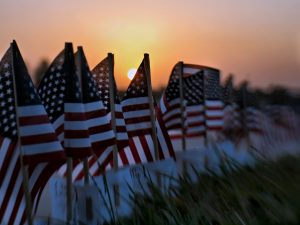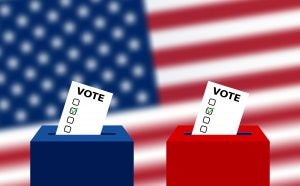Though not always given due credit, rural Americans, namely agriculturalists and those of similar blue-collar industries, are pretty keen on politics. There’s a reason they have entire organizations dedicated to expressing concerns, lobbies, and appeals to Washington on their behalf. Global and domestic political concerns are regular discussions at the local grain elevators and commonplace in nearly every ag newsletter. Even the small-scale part-time farmer is known to keep a steady pulse on elections, candidates and various issues.
Presidential elections are no exception to this. However, the qualities and make-or-break points of candidates tend to differ in flyover state country compared to the coastal metropolises. It was these unified values of the rural American minority that was pivotal in swinging the hotly debated 2016 presidential election.
And ever since then, people have threatened to put the Electoral College on the chopping block.
A few years back, USA Today had an opinion piece on the importance of the college in rural America, which made the rounds on social media. You can find countless similar articles voicing support and opposition to the matter all over the internet, and you can expect to see more as another presidential election creeps up.
The Electoral College is certainly one of the more difficult parts of our constitution to explain and one of the easier to misinterpret. At a glance, it can appear somewhat anti-democratic. But when we look through the lenses of the most vulnerable and smallest minority in the nation — that is, every individual person — we begin to understand the case isn’t an anti-democratic policy. Rather, it is a measure put in place to limit full unbridled democracy in favor of offering more protection to the individuals from the overreaches of government and their fellow citizens.
In a pure democracy, any faction — namely one group with a common interest — could overtake any election solely based on the size of its following. After all, the concerns and ideology of the numerical masses do not necessarily reflect the best interest of anyone. It’s hardly difficult to believe that by and large, it is very easy for a powerful faction to be careless with the rights and needs of others, especially when the “others” are in the numerical minority.
The Founders recognized the importance of rights and interests on the individual level. This is why there were such precautions taken against creating a government based on a “majority rules” ideology and pure democracy. Alexander Hamilton goes to great lengths to illustrate this in The Federalist Papers.

I bring this to your attention because the divide back in the 2016 Trump-Clinton election illustrated such a situation and purpose to a T. Specifically, there were certain issues of interest to those reliant on rural economies that urban-dwelling majority tends to not consider before casting their ballots. Matters of business, trade, tariffs, supply, markets, and industrial interest tend to be at the forefront of ag-backgrounded voters. Compare this to major coastal cities, with citizens who pushed domestic and social concerns as the guiding principles of their decisions.
Both sides have causes worthy of consideration and support, but they do represent starkly different criteria in selecting a president.
You could argue the opinions and interests of the rural community as either being right or wrong. And yes, they could be considered a faction in and of themselves. However, the Electoral College is the only thing that makes it possible for them to even have the opportunity to make an impact on the outcome. If popular vote were the ultimatum, the largest faction (primarily made up of urban-dwellers) would always have the final say.
Based on population size, 10 states (California, Texas, Florida, New York, Illinois, Pennsylvania, Ohio, Georgia, North Carolina, and Michigan) could determine any given election. The population of New York City alone is greater than that of 38 states. In terms of geography (and according to the United States Census Bureau) rural areas cover 97 percent of the nation’s land (and let’s not forget natural resources, agriculture, et cetera!) yet contain only 19.3 percent of the total population.
So where a direct popular vote for national office leave supply-chain economics such as food production, manufacturing, and the supply of raw materials?
Consider how the blue-collar workforce in the U.S., a minority though they be, are a sort of watchdog. They tend to be more “in the know” of the real-world effects on local and national economies. Remember, those with paychecks as volatile as the commodity markets are few and far between. With these voters comes some very unique perspectives and sensitivity to the political climate. It’s fair to ask — what might we be missing out on by minimizing their ballot-box impact?
What may just be another social concern to one person is a matter of critical importance to farmers. For example, immigration policy is the difference between crops rotting on the vine and a sustainable food system. The current H-2A Program provides less than 4 percent of the 1.5 million to 2 million hired workers needed in agriculture. The American Farm Bureau did an excellent piece on this issue and what changes agriculture needs to see in its regard. Farmers want policies that don’t just seem appealing, they want ones that are workable for their profitability and their employees.

While many politicians and political enthusiasts drag out the battle over the SNAP program and other issues in each farm bill, farmers sit impatiently hoping for success with the Dairy Margin Coverage program and fair crop insurance. Back in 2018 for that farm bill, few outside of agriculture seemed to understand the urgency that came with being the third lowest year for net farm income in the past two decades.
Such examples are only a drop in the bucket of the innumerable political anxieties that plague farmers from all sides, year after year. Tough markets, unfair payment and difficult economies (both domestic and international) make them veer toward candidates who not only acknowledge, but have an aggressive plan of support, their interests. Making up a mere 2 percent of the population, it’s evident why farmers and ranchers must continue to put their underrepresented concerns in economics and business first.
When the Electoral College falls in favor of the masses it’s praised; when it’s in favor of the minorities, it’s challenged and scorned. No system is a surefire way to guarantee the success of a presidential candidate or that the best decisions are always made. But the college at least gives a chance for the voice of the individuals who are a driving force behind the economy to be heard.
Those flyover states may be somewhat neglected along the campaign trail, but we know when they’ve made their mind up on something and speak with one voice, they have the power necessary to make an impact.
Jaclyn Krymowski is a graduate of The Ohio State University with a major in animal industries and minor in agriculture communications. She is an enthusiastic agvocate, professional freelance writer, and blogs at the-herdbook.com.



